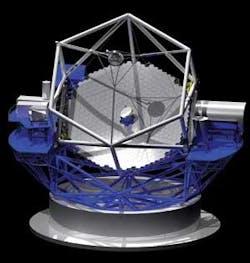Thirty Meter telescope is approved by Hawaiian board
Mauna Kea, HI--The Hawaiian Board of Land and Natural Resources (BLNR) has granted a permit to the Thirty Meter Telescope (TMT) project to build and operate the next-generation observatory near the summit of Mauna Kea. With its 492-segment, 30-m-aperture mirror housed in a 66-m-diameter structure, TMT will be one of the largest diffraction-limited optical telescopes in the world, superseded in size only by the planned European Extremely Large Telescope (E-ELT) with an aperture of 42 m.
Related: Bigger is better for ground telescopes: Super-giants will reach 24 to 42 m
Related: Non-pulsed laser guide star funded to improve Keck II telescope AO imaging
RAS 'welcomes' decision to build E-ELT, world’s largest optical telescope
Scheduled to begin scientific operations in 2021, TMT is the result of a collaboration between the California Institute of Technology (Caltech), University of California, the Association of Canadian Universities for Research in Astronomy, the National Astronomical Observatory of Japan, a consortium of Chinese institutions led by the National Astronomical Observatories of the Chinese Academy of Sciences, and institutions in India supported by the Department of Science and Technology of India. The Gordon and Betty Moore Foundation has committed $250 million to fund the design, development, and construction of the TMT.
Fitting into the mountaintop niche
TMT's size makes it potentially ecologically sensitive; in addition, Mauna Kea is a sacred location for many of Hawaii's native inhabitants. The TMT group had to educate itself on the cultural and religious significance of the sacred mountain, as well as its ecosystems, then work with local interests to minimize potential negative impacts and maximize benefits.
"Over the last several years, the TMT project has welcomed the support it has received from all sectors of the Hawaiian community, from education to cultural to business to labor," says Sandra Dawson, TMT's Manager of Hawaii Community Affairs. "We look forward to beginning construction and becoming a neighbor of the outstanding observatories on Mauna Kea."
In February 2011, the BLNR issued a preliminary decision conditioned on the successful conclusion of a contested case. The contested hearings began later that year. The final approval followed a hearing held February 12, 2013 in Hilo, HI duringwhich the BLNR reviewed a report by the hearing officer regarding the contested case.
TMT will now seek final approval of construction plans by Hawaii's Department of Land and Natural Resources (DLNR). The project will also negotiate a sublease with the University of Hawaii. TMT plans to begin preparing the ground for construction on Mauna Kea before the end of the year with a construction start date slated for April 2014.

John Wallace | Senior Technical Editor (1998-2022)
John Wallace was with Laser Focus World for nearly 25 years, retiring in late June 2022. He obtained a bachelor's degree in mechanical engineering and physics at Rutgers University and a master's in optical engineering at the University of Rochester. Before becoming an editor, John worked as an engineer at RCA, Exxon, Eastman Kodak, and GCA Corporation.
